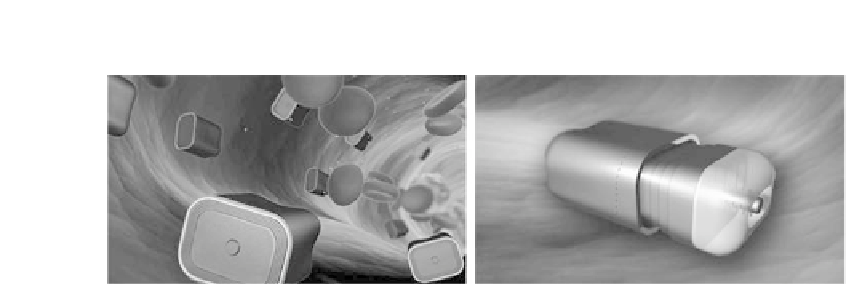Information Technology Reference
In-Depth Information
Figure
15.3.
Artist's conceptions of the basic chromallocyte [7] design: devices
walking along luminal wall of blood vessel (left); telescoping funnel assembly
and proboscis manipulator in extended position (right). [
2006 Stimulacra LLC
(www.stimulacra.net) and Robert A. Freitas, Jr. (www.rfreitas.com)]
r
the originals. The chromallocyte (Fig. 15.3) will be capable of limited vascular
surface travel into the capillary bed of the targeted tissue or organ, followed by
diapedesis (exiting a blood vessel into the tissues) [1ao], histonatation (locomotion
through tissues) [1ap], cytopenetration (entry into the cell interior) [1aq], and
complete chromatin replacement in the nucleus of the target cell. The CRT
mission ends with a return to the bloodstream and subsequent extraction of the
device from the body at the original infusion site. Replacement chromosomes are
manufactured in a desktop ex vivo chromosome sequencing and manufacturing
facility, then loaded into the nanorobots for delivery to specific targeted cells
during CRT. A single lozenge-shaped 69 micron
3
chromallocyte measures 4.18
microns and 3.28 microns along cross-sectional diameters and 5.05 microns in
length, typically consuming 50-200 pW in normal operation and a maximum of
1000 pW in bursts during outmessaging, the most energy-intensive task. Treat-
ment of an entire large human organ such as a liver, involving simultaneous CRT
on all 250 billion hepatic tissue cells, might require the localized infusion of a
1
B
terabot (10
12
devices)
69 cm
3
chromallocyte dose in a 1-liter 7% saline suspen-
B
sion during a
7 hour course of therapy.
The chromallocyte includes an extensible primary manipulator 4 microns long
and 0.55 microns in diameter called the Proboscis that is used to spool up
chromatin strands via slow rotation when inserted into the cell nucleus. After
spooling, a segmented funnel assembly is extended around the spooled bolus of
DNA, fully enclosing and sequestering the old genetic material. The new
chromatin is then discharged into the nucleus through the center of the Proboscis
by pistoning from internal storage vaults, while the old chromatin that is
sequestered inside the sealed watertight funnel assembly is forced into the storage
vaults as space is vacated by the new chromatin that is simultaneously being
pumped out. The chromallocyte includes a mobility system similar to the
microbivore grapple system, along with a solvation wave drive [1ar] that is used
to ensure smooth passage through cell plasma and nuclear membranes.
B






Search WWH ::

Custom Search